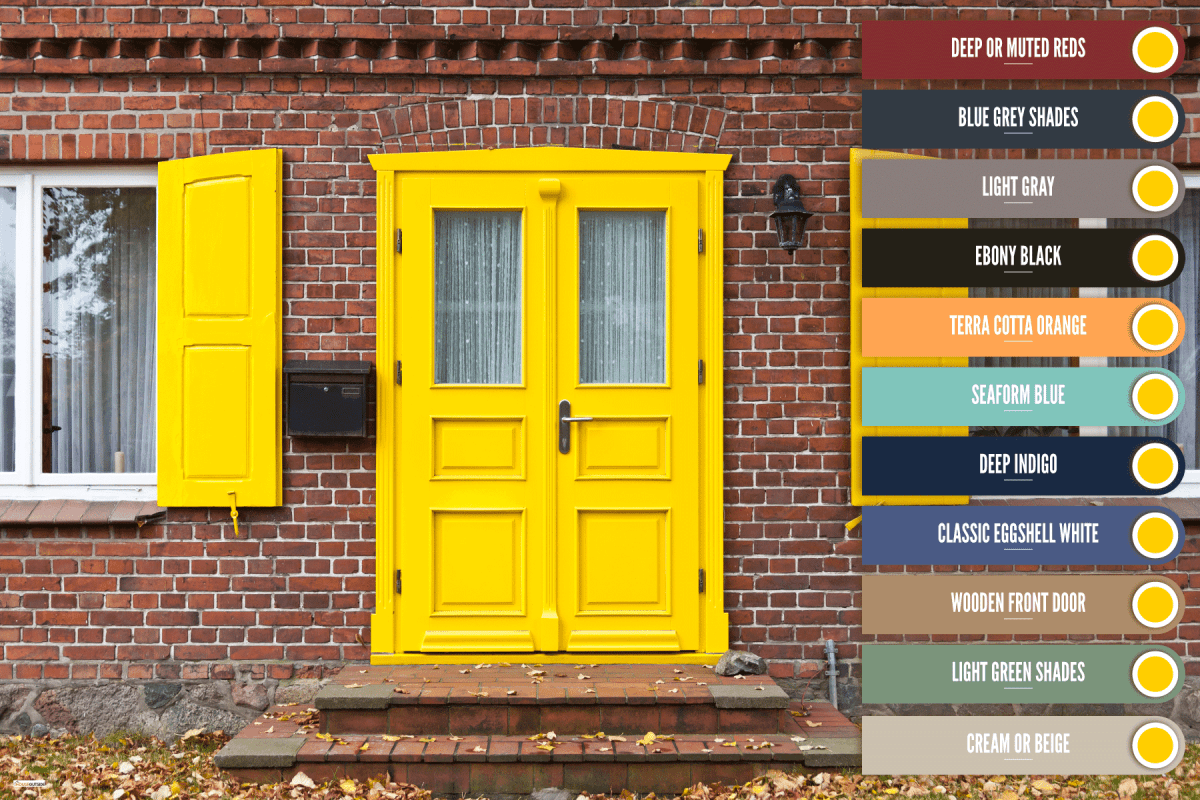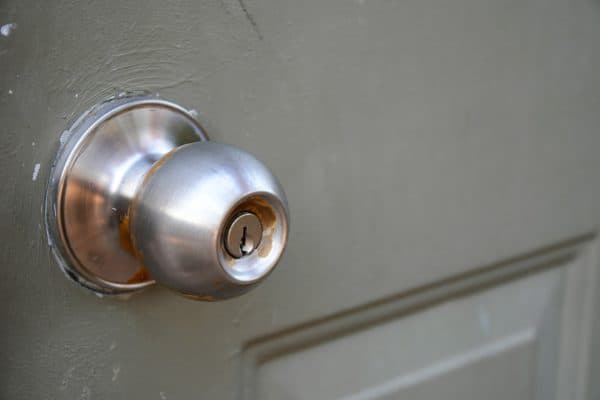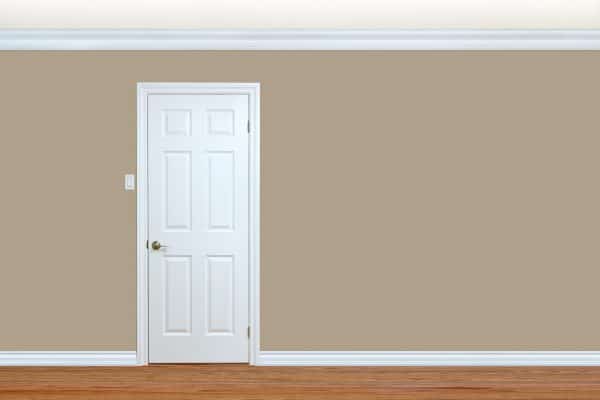Choosing the right color scheme for your exterior can be intimidating. It's the first thing people will see, so you would want to make a great first impression.
Yellow sidings make the house look bright, cheery, and inviting, but it's not exactly a neutral color. This makes it challenging to pair with other colors since they could easily clash with vibrant hues like yellow.
A good rule of thumb is always referring to the color wheel. You can pair analogous or complementary colors or be experimental and choose contrasting shades to pair with your yellow siding.
Analogous colors are those next to each other in the color wheel, while complementary colors are those on the opposite side. Use this basic knowledge as a foundation when picking out shades and hues.
Your front door is not just there for function; it also contributes a lot to the overall design of your house, so it's important to consider its aesthetic value as well. Fortunately, many door colors and materials blend with yellow sidings, so you have a decent number of options.
As always, make sure you choose a front door color that is cohesive with your exterior design, and one that matches your personal style.

We have gathered front door colors and materials that will elevate the look of your home so your home can look consistently lovely. Keep reading below to learn more!
1. Deep or Muted Reds
Red is a complementary color of yellow, so it makes sense to choose this front door color to go with your yellow siding. It makes your house look effortlessly charming, and gives off a cozy storybook-home vibe, especially if you decorate it that way.
The muted shade of red makes it less visually overwhelming so viewers can focus on how the colors work together instead of focusing on the stark-colored front door.
Read: Does Aluminum Siding J Channel Around Windows?
2. Blue-Grey Shades
If you want a cosmopolitan splash on your cozy-looking home, go with a blue-grey-colored front door. The door will effortlessly blend into the background, making the eyes go to the other features of your home.
This shade is also more versatile since it goes with any decorations. It matches any holiday theme, and you can freely change your style without worrying if the front door color will clash with your new design.
3. Light Grey
Light grey is a good and softer alternative to blue-grey. It tones down the vibrancy of yellow and makes it look more balanced, making the whole look more modern and effortlessly polished.
It's also aesthetically versatile, and if you choose to brighten your siding, your grey front door will tie up the color scheme neatly.
Light grey front doors are also ideal if you have wooden trims paired with yellow siding. It will not clash with any of the colors, and it will make the color scheme feel less overwhelming.
It's important to have a balancing factor in every exterior design. You would want the viewers to look at the whole picture instead of focusing only on one feature of the house.
4. Ebony Black
Black front doors will contrast sharply with your yellow sidings, creating visual appeal. It also provides visual stimulation, making your house look effortlessly artistic and unique.
Black front doors will also inject a sense of modernity into your house, toning down its cozy charm and making it look more balanced.
However, black front doors can show dirt and soot more easily because of their stark color. This has its share of pros and cons, namely that it would be easier for you to get rid of the dirt if you can see it easily. However, it will also show the tiniest speck of dirt, which can be irritating at times.
5. Terra Cotta Orange
Terra cotta-colored front doors highlight the cozy, storybook charm of yellow houses. You can choose this front door color if you want your home to look welcoming and warm. This color scheme is a good alternative to white and wood colors, which are common in country home-inspired houses.
This will make your home look more unique and effortlessly whimsical, which can be difficult to achieve with strictly neutral colors.
The color scheme is not particularly aesthetically versatile since it is a statement in itself. However, you can tie the colors together with wooden accents to make the look more balanced.
6. Seafoam Blue
If you want a more refreshing vibe, choose a beach-themed color scheme. This color scheme is often composed of blues, yellows, and browns. Seafoam blue has a lighter shade, making your home look bright and airy especially when it's paired with vibrant yellow siding.
Your home can have a loosely greek-inspired design, which is ideal if you want your home to feel tranquil and cozy.
You can tie the colors together with light wood-toned materials, either on your trim or on your porch furniture.
7. Deep Indigo
Deep indigo is a good alternative to vibrant hues such as terra cotta or muted red. It will still have that cozy charm, but the contrast between yellow and indigo will give off an almost modern look that will make the house look more aesthetically balanced.
Indigo is a natural color, so pairing it with yellow makes sense. You can use it as a basis for a nature-inspired color scheme, which can be tied with light green accents. This can create a visually refreshing exterior, while also remaining unique and effortlessly charming.
8. Classic Eggshell White
White front doors are a tried and true design solution. It's a safe route if you don't want your color scheme to have a lot of texture and visual stimuli, and if you are more focused on creating a polished, elegant, and practical look.
Make sure to choose eggshell white since they have warmer undertones that blend with yellow better. Stark white can look a bit clinical or, ironically, visually overwhelming. Eggshell white will look more harmonious with a yellow home, leaning into its cozy and homey atmosphere.
9. Wooden Front Door
Wooden front doors are another classic solution if you have a yellow house. Wooden tones naturally pair well with yellow since they are both warm hues. You can lean better into a rustic or farmhouse-inspired home with this color scheme, making the exterior look cozy and welcoming.
There are many wooden doors you can incorporate into your yellow house. Alder is a good wood since it can easily add character to a home with its textured and knotty surface. You can also use oak, which stains well and holds up against weather patterns.
If you want a darker wooden door for contrast, mahogany is a great option. It is the most durable wood material you can use. However, it can be pricey, so you can look into hickory or cherry as an alternative.
Read: Is Cedar Siding Hard To Maintain?
10. Light Green Shades
If you want an analogous color scheme that leans into a nature-inspired design, go with light green front doors. Sage green and yellow-green are both good options for this. The color scheme will be visually relaxing, and it will still give off that charm and coziness that is often present with yellow houses.
You can tie up this color scheme with classic white trims, or with wooden trims. Both will balance the look of your house, although wooden trims will outline your exterior better and provide visual stimulation.
11. Cream or Beige
Cream and beige are good alternatives to white front doors. They have warm undertones that match yellow sidings, and they blend well into the background if that's your preference.
They are versatile, so you can change up your style freely. However, cream front doors can make the house look a bit plain, so you can opt for darker trims to create visual contrast. Take advantage of having a neutral front door by decorating your porch and experimenting with other colors for the trims.
Final Thoughts

There are a lot of ways you can make your exterior's color scheme work together, but you can start figuring out what color to incorporate on your front door.
Your front door may be a subtle feature compared to the siding, but it will determine what your trim color would be, so it could create a domino effect. So, make sure to pick hues that complement the house's overall color scheme.


